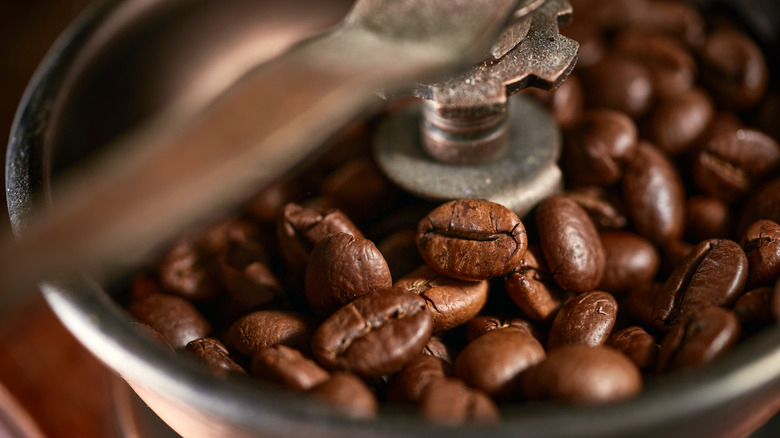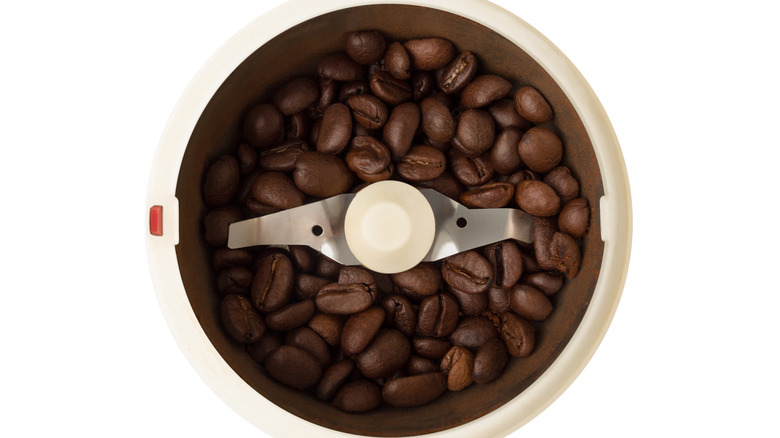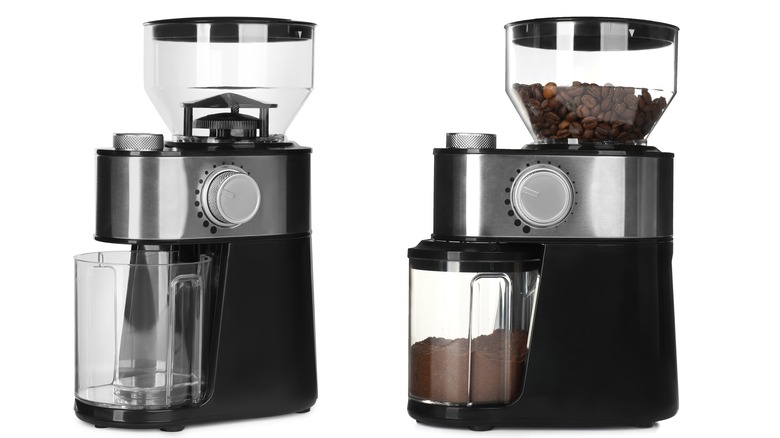What's The Difference Between A Burr And A Blade Coffee Grinder?
We may receive a commission on purchases made from links.
Three-quarters of Americans drink coffee every day (per Drive Research), and the vast majority of them brew it at home. While there's certainly no shame in snagging some fast-food coffee instead, the world of homebrew can be a complex world for newcomers. Once you fall down the rabbit hole of making your own coffee, you should be prepared to explore every single aspect of the energy-granting drink.
Indeed, in this industry, there is nary an ounce of minutia not worth digging into for some substantial amount of time. According to Maps Coffee, the most dedicated of homebrew aficionados see fit to investigate everything from the origin of their coffee beans to the optimal temperature for sipping. Each aspect is up for debate, and many are out of your hands. Of the many decisions to be made in homebrewing, one of the most debated topics comes from the grind size of the beans, something that can have a huge impact on the final result of the coffee.
Just like the coffee industry has three waves (per Craft Beverage Jobs), an at-home coffee brewer will probably advance through three stages of grinding. The first stage is realizing you want to grind beans yourself. According to the National Coffee Association, the ultimate coffee is ground immediately before brewing. The next two steps require the right tool. Down the rabbit hole, we go.
Blade coffee grinders are entry-level grinders
According to Java Presse, blade coffee grinders are fast, easy to find, and normally cost less than $20. They're simple to use and small enough to stash in a cupboard. Those reasons make it a common entry point for folks who are ready to grind their own beans. These look like mini food processors. Blades are spun in the bottom of the grinding chamber fast enough to toss the coffee beans around and into the blades.
The downfall for most homebrew enthusiasts is never being entirely certain your coffee is ground to the right size. No matter what, the grinds will be within a wide range, from powder fine to an entire bean that miraculously missed the blades. The coffee will be muddied from those fine particles.
Still, even inconsistently ground fresh beans are probably better than coffee ground weeks ago. So, Coffee Confidential offers a few tips to get the best results out of a blade coffee grinder. To help get an even grind, pulse the power button, and shake the grinder. This should help ensure more even results. Also, pay attention to the time. For coarse grinds, it's recommended that you grind for eight to 10 seconds, while medium grinds require up to 15 seconds.
If you're ready to upgrade out of blade grinders for coffee, don't toss it. There are at least five things you didn't know your coffee grinder could do. Just be sure to not grind any more coffee, after grinding spices.
Burr grinders are the ultimate coffee grinder
Java Presse identifies burr grinders as the third and final stage of coffee grinding. These work like a peppermill as the beans are fed between two sets of burrs. The distance between those burrs determines the grind size. These are the coffee industry standards that you hear whirring away at coffee shops.
They produce uniform grinds that can be adjusted to the exact size you need for every brewing type. Perfectly uniform grinds brew into coffee that's clean and balanced. Unlike inexpensive blade grinders, burr grinders will last years. On the downside, that precision and durability come at a steep price. Even hand-cranked models, designed for small batches of grinding, will be more than $20. The Way to Coffee reviews manual grinders, and the two favorites are either $60 or $350. No matter the price, they're slow.
Electric burr grinders are probably a better bet. They're heavy enough to warrant a set spot on the counter, and they can set you back hundreds of dollars. Thankfully, America's Test Kitchen put a lineup of these to the test. The outlet's favorite electric burr grinder, the Baratza Encore Conical Burr Coffee Grinder, is $118.95 on Amazon. The Capresso Infinity Conical Burr Grinder is deemed a "Best Buy" and comes in at less than $100 on Amazon. With either of these, you're one step closer to becoming your own barista.


